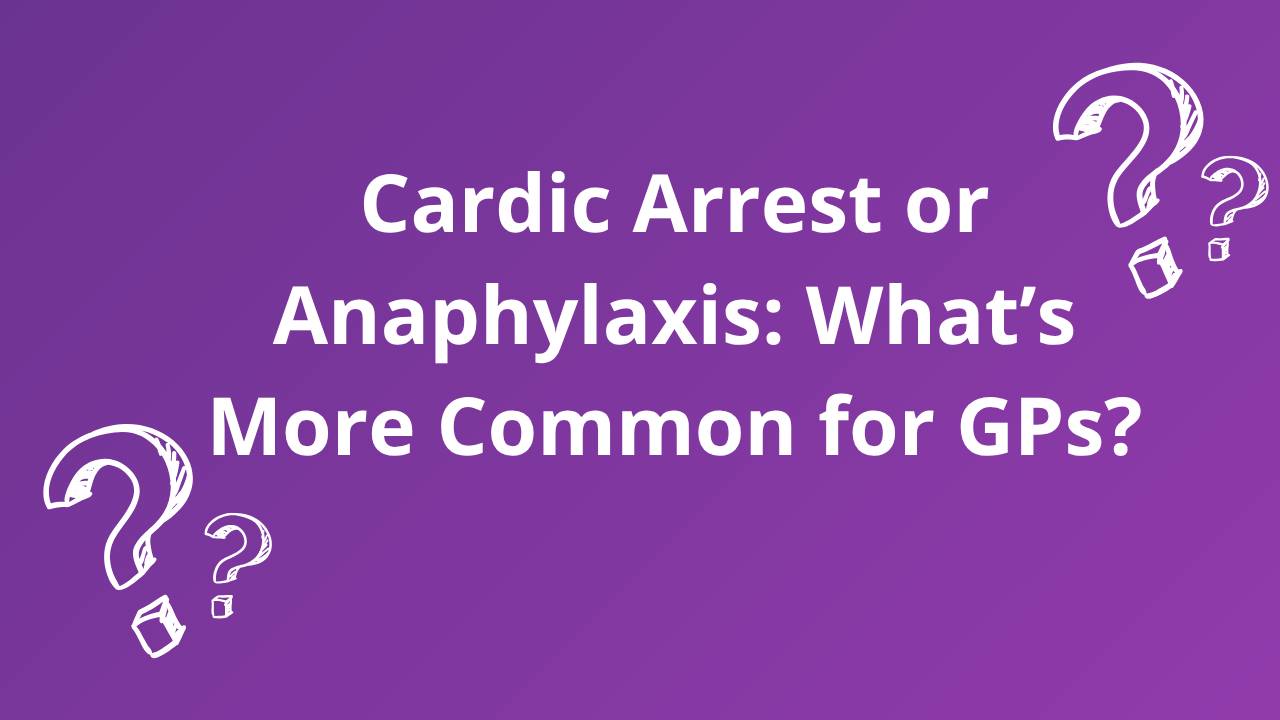Cardiac Arrest or Anaphylaxis: What’s More Common for GPs?
Nov 05, 2025
Most GPs spend significant time preparing for CPR and cardiac arrest scenarios but what if the emergency you are most likely to face isn’t a cardiac arrest at all?
Many GPs focus heavily on their preparedness for managing a cardiac arrest and performing CPR. While you are up to 50 times more likely to encounter anaphylaxis than a cardiac arrest in general practice and the incidence of anaphylaxis is continuing to increase.
This shift in emergency risk has major implications for GP preparedness, training, and clinical governance. Importantly, when death from anaphylaxis occurs in a clinical setting such as a GP practice, the mean time to death is approximately 5 minutes¹, leaving little to no margin for hesitation or “learning in the job.”
Understanding the Statistics: Cardiac Arrest in General Practice
A study found only 216 cardiac arrests occurred in Victorian general practice across a 20-year period, equating to approximately 10.8 cases per year statewide². When extrapolated nationally, this represents an estimated 42 cases annually across Australia, confirming that a cardiac arrest in general practice is extremely rare.
Why Anaphylaxis Is More Likely in GP Settings
Depending on your type of practice, your exposure to anaphylaxis risk is significantly higher due to routine primary care procedures, including:
- Vaccinations
- Iron infusions
- Intramuscular or intravenous medications including antibiotics
- Management of allergic reactions such as insect/bee stings presenting in your rooms
While exact statistics on anaphylaxis specifically within general practice are not available, the Australian Commission on Safety and Quality in Health Care’s Acute Anaphylaxis Clinical Care Standard³ reports a 35% increase in anaphylaxis-related hospital admissions, rising from 9,042 in 2015 to 12,179 in 2020. A notable proportion of these cases are likely to initially present or require immediate management in primary care settings.
It is also important to consider that should an anaphylaxis case occur in your practice, your personal statistic at that moment is 100% and you must be prepared to manage it effectively.
What Does Best Practice in Anaphylaxis Management Involve?
All clinicians are required to apply “best practice” when managing anaphylaxis. The Australian Commission on Safety and Quality in Health Care in its Acute Anaphylaxis Clinical Care Standard³, specifically requires general practitioners (GPs) to apply best practice in the management of anaphylaxis.
This includes a through understanding of:
- The 7 steps of anaphylaxis management⁴
- The ASCIA Acute Management of Anaphylaxis for Health Professionals Guidelines⁵
These two resources provide protocols that go well beyond the simple administration of IM adrenaline, including how to manage anaphylaxis when IM adrenaline is ineffective.
As discussed in my blog “What are the 5 Possible Clinical Pathways for a patient in Anaphylaxis” anaphylaxis management may require more steps than just IM adrenaline including IV fluids, IV adrenaline infusions, nebulised adrenaline and cardiac arrest management, again with specific requirements and all of this may occur before the ambulance arrives. Some of these advanced managements will require you to have an ED or ICU specialist on the phone, so preparation and protocols are essential.
National Standards and Clinical Expectations
The Australian Commission on Safety and Quality in Health Care, has released the Acute Anaphylaxis Clinical Care Standard³ to address “unwarranted variation” in anaphylaxis management across healthcare settings.
In other words, they are saying that overall, anaphylaxis management requires improvement with greater training and increased skill sets for clinicians.
This clinical care standard is very important, as it has both clinical implications and accreditation requirements.
The Commission states that the clinical care standard applies to
- General practices
- General Practitioners
- Practice nurses
- Allied health professionals
- Students who provide health care under supervision
The Commission expects everyone to be comply with the standard.
In summary, anaphylaxis is far more likely to present than a cardiac arrest in general practice. This makes it essential for GPs and their teams to undergo comprehensive anaphylaxis training which is based upon the ASCIA guidelines and to have clear, evidence-based protocols and procedures in place. Being prepared ensures you can confidently manage any of the five potential clinical pathways and remain aligned with best practice and current clinical guidelines.
Click here to enrol in our comprehensive anaphylaxis management courses, where you’ll gain a clear understanding of best-practice management, escalation pathways, and how to meet guideline and accreditation requirements with confidence.

